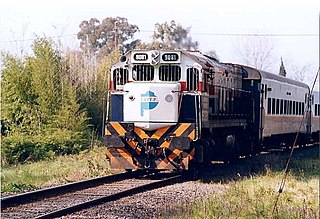
The Unidad Ejecutora del Plan Ferroviario Provincial (UEPFP), mostly known for its trade name Ferrobaires, was a public railway company which operated extensive long-distance passenger trains throughout Buenos Aires Province in Argentina. The company was primarily owned and funded by the Buenos Aires provincial government led by Eduardo Duhalde. The name "Ferrobaires" is a combination of the Spanish words for "Rail Buenos Aires."
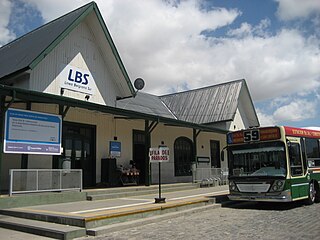
Buenos Aires is a former passenger railway station in the city of Buenos Aires, Argentina. The station was terminus of the Belgrano Sur line that runs trains along Greater Buenos Aires region.

Ferrovías S.A.C. is a privately owned company which, on 1 April 1994, took over the concession, granted by the Argentine government as part of railway privatisation during the presidency of Carlos Menem, for the operation of the 1,000 mm Belgrano Norte Line commuter rail service in Buenos Aires, Argentina.

Metrovías S.A. is an Argentine privately owned company that operates the Buenos Aires Underground and the Metropolitan services of Urquiza Line. 90% of Metrovías' shares are held by Grupo Roggio.

The General San Martín Railway (FCGSM), named after the former Argentine general José de San Martín, was one of the six state-owned Argentine railway companies formed after President Juan Perón's nationalisation of the railway network in 1948. The six companies were managed by Ferrocarriles Argentinos which was later broken up during the process of railway privatisation beginning in 1991 during Carlos Menem's presidency.

Unidad de Gestión Operativa Ferroviaria de Emergencia (UGOFE) was a temporary consortium of Argentine companies formed on 7 January 2005 by Ferrovías, Metrovías and Trenes de Buenos Aires to take over the running of commuter railway services in Buenos Aires after concessions granted to Metropolitano in 1994 for the operation of these services were revoked.
Ferrocarriles Metropolitanos S.A. was a company set up by the Argentine government in 1991, during the presidency of Carlos Menem, to oversee the privatisation of commuter rail services within the city of Buenos Aires in Argentina. The company granted concessions to Metropolitano, Ferrovías, Metrovías, and Trenes de Buenos Aires for the operation of services which had previously been run by state-owned companies since the nationalisation of the railways in 1948. With its task complete, FEMESA was wound up in 1997.

Puente Alsina is an Argentine railway station in the Greater Buenos Aires neighbourhood of Valentín Alsina in the Lanús partido of Buenos Aires Province. The station takes its name from the nearby bridge of Puente Alsina over the Riachuelo River. On the other side of this bridge lies the neighbourhood of Nueva Pompeya within the city of Buenos Aires.
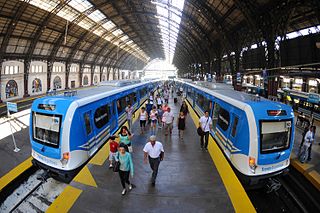
The Mitre line is an Argentine broad gauge commuter rail service in Buenos Aires Province as part of Ferrocarril General Bartolomé Mitre. The service is currently operated by State-owned company Operadora Ferroviaria Sociedad del Estado after the Government of Argentina rescinded contract with Corredores Ferroviarios in March 2015.

The San Martín line is a 70-kilometre (43 mi), 22-station commuter rail service in the metropolitan area of Buenos Aires, Argentina. The San Martín line operates from the city-centre terminus of Retiro north-west to Doctor Cabred in Luján Partido along a broad gauge line built by the British-owned Buenos Aires and Pacific Railway.

The Roca line is a 1,676 mm gauge commuter rail service in the Buenos Aires Province, Argentina, part of General Roca Railway network. The service is currently operated by State-owned company Trenes Argentinos, from the city-centre terminus of Constitución south to Ezeiza, Alejandro Korn, La Plata, Cañuelas, Chascomús, Gutiérrez and Lobos, and west to Sarmiento Line's station Haedo. The transfer stations between the branch lines are Avellaneda, Temperley, Bosques and Berazategui.
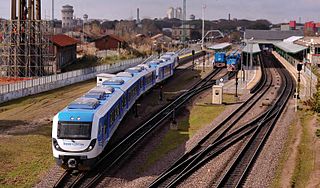
The Belgrano Sur line is an Argentine 1,000 mmmetre gauge commuter rail service in the Greater Buenos Aires area, currently operated by state-owned enterprise Trenes Argentinos. The Belgrano Sur runs over tracks and stations built by the Franco–Belgian-owned Compañía General de Buenos Aires and British Midland companies at the beginning of the 20th century.

Railway privatisation in Argentina was a process which began in 1993 under the presidency of Carlos Menem, following a series of neoliberal economic reforms. This primarily consisted of breaking up the state-owned railway company Ferrocarriles Argentinos (FA) and allowing the former lines to be operated by private companies instead of the state. This policy was met with widespread criticism and proved catastrophic for the Argentine railways whose service worsened significantly in the years that followed, with entire lines closing and infrastructure deteriorating beyond repair. Privatisation was ultimately reversed in 2015 with the creation of Nuevos Ferrocarriles Argentinos.
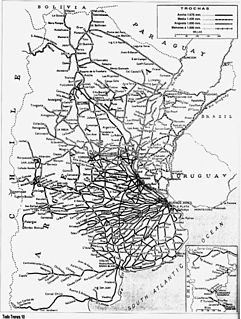
The Argentine railway network consisted of a 47,000 km (29,204 mi) network at the end of the Second World War and was, in its time, one of the most extensive and prosperous in the world. However, with the increase in highway construction, there followed a sharp decline in railway profitability, leading to the break-up in 1993 of Ferrocarriles Argentinos (FA), the state railroad corporation. During the period following privatisation, private and provincial railway companies were created and resurrected some of the major passenger routes that FA once operated.

Unidad de Gestión Operativa Mitre-Sarmiento (UGOMS) was a temporary consortium of Argentine companies formed on 24 May 2012 by Ferrovías and Metrovías to take over the running of the Sarmiento and Mitre commuter rail lines, after concessions granted to Trenes de Buenos Aires (TBA) in 1995 for the operation of these services were revoked.

Operadora Ferroviaria Sociedad del Estado is an Argentine state-owned company created in 2008 to operate passenger services in Argentina. It is a subsidiary of the Ferrocarriles Argentinos holding company.

Argentren S.A. was an Argentine private company that operated the Belgrano Sur and Roca railway services in Buenos Aires Province for about one year until the Government of Argentina rescinded the agreement with the company in March 2015. Since then, the Mitre and San Martín line are operated by State-owned company Operadora Ferroviaria Sociedad del Estado (SOFSE).

Corredores Ferroviarios was an Argentine private company that operated the Mitre and San Martín railway services in Buenos Aires Province for about one year until the Government of Argentina rescinded the agreement with the company in March 2015. Since then, the Mitre and San Martín line are operated by State-owned company Operadora Ferroviaria Sociedad del Estado (SOFSE).

The CSR EMU is a series of electric multiple unit cars manufactured by CSR Corporation Limited for use on Buenos Aires' commuter rail network. The trains operate on three of the city's lines as of 2015 and 705 cars were manufactured, with each line using a different number of cars per train. They were created for use on lines electrified using both third rail and overhead lines.

The Toshiba EMU is an electric multiple unit train model used in the Roca Line in the Southern Buenos Aires Metropolitan Area, Argentina.





















